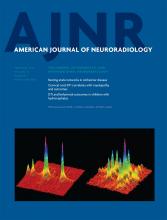Index by author
Wong, H.-F.
- FELLOWS' JOURNAL CLUBNeurointerventionYou have accessProspective Comparison of Angio-Seal versus Manual Compression for Hemostasis after Neurointerventional Procedures under Systemic HeparinizationH.-F. Wong, C.-W. Lee, Y.-L. Chen, Y.-M. Wu, H.-H. Weng, Y.-H. Wang and H.-M. LiuAmerican Journal of Neuroradiology February 2013, 34 (2) 397-401; DOI: https://doi.org/10.3174/ajnr.A3226
This article addresses the utility of Angio-Seal versus manual hemostasis in anticoagulated patients following neurointerventional procedures. In a study of 174 punctures, 104 were closed with Angio-Seal and the rest with manual compression. All patients had activated clotting time values between 250–500 seconds at the time of closure. Mean hemostasis times were significantly longer with manual compression and hematomas 3 times more common. Using Angio-Seal led to arterial occlusion in 1 patient who was successfully revascularized. Thus, Angio-Seal is fast and effective in this setting.
Wong, J.
- NeurointerventionYou have accessCanadian Experience with the Pipeline Embolization Device for Repair of Unruptured Intracranial AneurysmsC.J. O'Kelly, J. Spears, M. Chow, J. Wong, M. Boulton, A. Weill, R.A. Willinsky, M. Kelly and T.R. MarottaAmerican Journal of Neuroradiology February 2013, 34 (2) 381-387; DOI: https://doi.org/10.3174/ajnr.A3224
Wong, J.H.
- EDITOR'S CHOICEExpedited PublicationYou have accessPipeline Embolization Device in Aneurysmal Subarachnoid HemorrhageJ.P. Cruz, C. O'Kelly, M. Kelly, J.H. Wong, W. Alshaya, A. Martin, J. Spears and T.R. MarottaAmerican Journal of Neuroradiology February 2013, 34 (2) 271-276; DOI: https://doi.org/10.3174/ajnr.A3380
The authors used the Pipeline device to treat 20 patients with acutely ruptured intracranial aneurysms. The most common types of aneurysms treated were blister and dysplastic/dissecting. Procedure-related morbidity/mortality overall was 15%, and 1 death directly related to the procedure occurred. Occlusion rates were 75% and 94% at 6 months and 12 months, respectively. The authors concluded that the Pipeline device offers a feasible treatment option in acute or subacute ruptured aneurysms, especially the blister type. Ruptured giant aneurysms remain challenging for both surgical and endovascular techniques; at this stage, the Pipeline device should be used with caution in this aneurysm subtype.
Wright, K.
- Pediatric NeuroimagingYou have accessImaging Changes in Very Young Children with Brain Tumors Treated with Proton Therapy and ChemotherapyN.D. Sabin, T.E. Merchant, J.H. Harreld, Z. Patay, P. Klimo, I. Qaddoumi, G.T. Armstrong, K. Wright, J. Gray, D.J. Indelicato and A. GajjarAmerican Journal of Neuroradiology February 2013, 34 (2) 446-450; DOI: https://doi.org/10.3174/ajnr.A3219
Wu, X.
- FunctionalOpen AccessAlterations of Directional Connectivity among Resting-State Networks in Alzheimer DiseaseR. Li, X. Wu, K. Chen, A.S. Fleisher, E.M. Reiman and L. YaoAmerican Journal of Neuroradiology February 2013, 34 (2) 340-345; DOI: https://doi.org/10.3174/ajnr.A3197
Wu, Y.-M.
- FELLOWS' JOURNAL CLUBNeurointerventionYou have accessProspective Comparison of Angio-Seal versus Manual Compression for Hemostasis after Neurointerventional Procedures under Systemic HeparinizationH.-F. Wong, C.-W. Lee, Y.-L. Chen, Y.-M. Wu, H.-H. Weng, Y.-H. Wang and H.-M. LiuAmerican Journal of Neuroradiology February 2013, 34 (2) 397-401; DOI: https://doi.org/10.3174/ajnr.A3226
This article addresses the utility of Angio-Seal versus manual hemostasis in anticoagulated patients following neurointerventional procedures. In a study of 174 punctures, 104 were closed with Angio-Seal and the rest with manual compression. All patients had activated clotting time values between 250–500 seconds at the time of closure. Mean hemostasis times were significantly longer with manual compression and hematomas 3 times more common. Using Angio-Seal led to arterial occlusion in 1 patient who was successfully revascularized. Thus, Angio-Seal is fast and effective in this setting.








